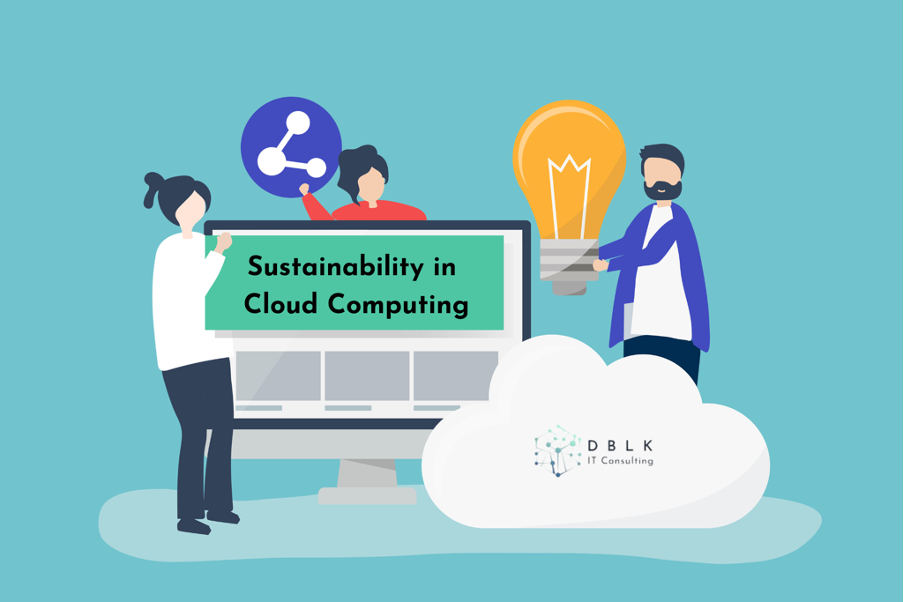The Future of Sustainability in Cloud Computing: Cutting-Edge Technologies and Initiatives for a Greener Tomorrow

Introduction to Sustainability in Cloud Computing
In recent years, cloud computing has become an integral part of the digital world. Technology has revolutionized the way businesses and individuals store and access data, improving efficiency and productivity. Despite its numerous advantages, the rapid growth of cloud computing has also raised concerns about its environmental impact, particularly in terms of energy consumption and carbon emissions. As a result, there has been a growing emphasis on sustainability in cloud computing, with the goal of minimizing its environmental footprint.
The current state of data centers and energy consumption is a pressing issue. Data centers are the backbone of cloud computing, housing the physical infrastructure that supports the storage, processing, and management of data. As the demand for cloud services continues to rise, so does the need for data centers. These facilities consume massive amounts of energy, contributing to the global carbon footprint and the depletion of finite natural resources.
In this blog article, we will explore the concept of green cloud computing, the cutting-edge technologies being employed to promote sustainability, and the initiatives being undertaken by major cloud providers to minimize their environmental impact. We will also discuss the role of the public cloud in sustainable digital transformation, strategies for businesses to achieve their sustainability goals with cloud computing, and the future potential and challenges of green cloud computing.
Green Cloud Computing: Definition and Benefits
Green cloud computing is an approach to cloud computing that focuses on reducing energy consumption, carbon emissions, and the overall environmental impact of data centers. The primary goal of green cloud computing is to create a more environmentally sustainable cloud infrastructure by adopting energy-efficient technologies and practices, utilizing renewable energy sources, and minimizing waste.
Cutting-Edge Green Cloud Technologies
Artificial Intelligence for Energy Efficiency
Artificial intelligence (AI) is playing a significant role in promoting energy efficiency in data centers. AI-based algorithms can analyze data on energy consumption, temperature, and workload patterns in real-time, enabling data centers to optimize their energy usage and minimize waste. This can include adjusting cooling systems, redistributing workloads, and even predicting and avoiding potential equipment failures that could lead to energy inefficiencies.
Higher Utilization Rates and Cloud Architecture
In traditional data centers, servers often operate at low utilization rates, wasting energy and resources. Green cloud computing aims to increase the utilization rate of servers through virtualization and containerization technologies, which enable multiple virtual machines or containers to run on a single physical server. This not only reduces the number of physical servers needed but also allows for more efficient use of resources and reduced energy consumption.
Furthermore, adopting a more energy-efficient cloud architecture can have a significant impact on sustainability. For example, edge computing, which involves processing data closer to its source, can reduce the amount of data transmitted over networks, thereby reducing energy consumption and latency.
Renewable Energy Sources for Data Centers
The use of renewable energy sources, such as solar, wind, and hydroelectric power, is another key aspect of green cloud computing. By harnessing these clean energy sources, data centers can significantly reduce their reliance on fossil fuels and decrease their carbon emissions. Some data centers are even exploring innovative ways of integrating renewable energy, such as using waste heat from servers to generate electricity or installing solar panels on their rooftops.
Major Cloud Providers and Their Sustainability Initiatives
The leading cloud providers, such as Amazon Web Services (AWS), Microsoft Azure, and Google Cloud, are increasingly prioritizing sustainability in their operations. These companies are investing in renewable energy projects, setting ambitious goals to achieve carbon neutrality, and implementing energy-efficient technologies and practices in their data centers.
For example, Google Cloud has committed to operating on 100% renewable energy and has achieved this goal for its global operations since 2017. Microsoft Azure is striving to become carbon negative by 2030 and remove all of its historical carbon emissions by 2050. AWS has set a goal to power its global infrastructure with 100% renewable energy by 2025 and has launched initiatives like the AWS Climate Pledge to promote sustainability practices among its partners and customers.
The Role of the Public Cloud in Sustainable Digital Transformation
A crucial part of fostering sustainable digital transformation is the use of public cloud services, which third-party providers offer online. By leveraging the shared infrastructure and resources of public cloud providers, businesses can reduce their own energy consumption, carbon emissions, and operational costs.
In addition to the inherent sustainability benefits of the public cloud, many providers are also committed to implementing green technologies and practices. This enables businesses to not only reduce their environmental impact but also contribute to the broader goal of creating a more sustainable digital ecosystem.
Strategies for Businesses to Achieve Sustainability Goals with Cloud Computing
Businesses seeking to adopt green cloud computing practices can take several steps to achieve their sustainability goals:
Evaluate and select cloud providers based on their commitment to sustainability and environmental performance. This may include assessing their use of renewable energy, energy-efficient technologies, and carbon reduction initiatives.
Optimize the utilization of cloud resources to minimize energy consumption and waste. This may involve using virtualization and containerization technologies, adopting energy-efficient cloud architectures, and leveraging AI-based solutions for energy management.
Monitor and measure the environmental impact of cloud computing activities, such as energy usage, carbon emissions, and resource consumption. This can help businesses identify areas for improvement and track progress toward their sustainability goals.
Develop and implement a comprehensive sustainability strategy that includes cloud computing practices. This may involve setting targets for energy efficiency, carbon reduction, and waste minimization, as well as engaging stakeholders in the process.
Measuring the Environmental Impact of Cloud Computing
In order to assess the effectiveness of green cloud computing efforts, it is crucial to measure the environmental impact of cloud computing activities. Power usage effectiveness (PUE), which calculates the proportion of a data center's overall energy consumption to that of its IT equipment, is one metric that can help with this. Lower PUE values indicate more efficient energy usage.
Other metrics to consider include carbon emissions, renewable energy usage, and resource consumption. By tracking these indicators, businesses can gain valuable insights into their cloud computing sustainability efforts, identify areas for improvement, and ensure that they are making progress toward their environmental goals.
The Future of Green Cloud Computing and Its Potential Challenges
The future of green cloud computing looks promising, with continued advancements in energy-efficient technologies and growing commitments from major cloud providers to prioritize sustainability. However, there are potential challenges that must be addressed in order to fully realize the potential of green cloud computing.
One challenge is the ongoing growth in demand for cloud computing services, which could offset the gains made through energy efficiency and renewable energy initiatives. Additionally, obstacles like cost, a lack of expertise, and regulatory restrictions may prevent the adoption of green cloud computing practices.
Despite these difficulties, market forces and regulatory pressures are likely to continue driving the push for greater environmental sustainability in cloud computing. As businesses and individuals increasingly recognize the importance of reducing their environmental impact, the adoption of green cloud computing practices is expected to become more widespread and transformative.
Conclusion: The Importance of Environmental Sustainability in Cloud Computing
In conclusion, the future of sustainability in cloud computing is one of great potential and opportunity. As cloud computing continues to grow and evolve, there is a pressing need to address its environmental impact and promote more sustainable practices. By embracing cutting-edge technologies, renewable energy sources, and innovative initiatives, the cloud computing industry can help pave the way for a greener tomorrow.
For businesses and individuals alike, the adoption of green cloud computing practices is not only an environmentally responsible choice but also a smart business strategy. By reducing energy consumption, carbon emissions, and waste, companies can lower their operational costs, enhance their reputation, and contribute to a more sustainable digital ecosystem. Ultimately, the future of cloud computing lies in its ability to balance innovation and growth with environmental sustainability, ensuring that the digital revolution can continue to thrive without compromising the planet's future.
